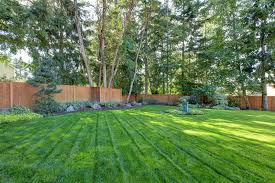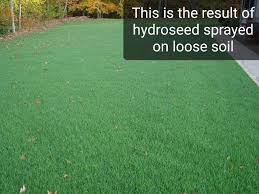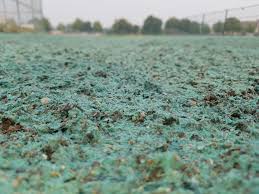Hydroseed, also known as hydraulic mulch seeding, is an innovative and environmentally-friendly method of establishing grass and vegetation in various landscapes. It is a process that involves spraying a slurry mixture consisting of water, seed, fertilizer, and a protective mulch onto the soil surface.
This technique is gaining popularity due to its efficiency and cost-effectiveness in achieving lush and healthy lawns, erosion control, and reclamation of disturbed areas.
The hydroseeding process begins with the preparation of the target area. The soil is properly graded and cleared of any debris to create a smooth and even surface. Once the area is ready, a hydroseeding machine is used to mix the seed, water, and other additives to create a thick, nutrient-rich slurry. This slurry is then evenly sprayed over the designated area, ensuring complete coverage.
One of the significant advantages of hydroseeding is its ability to promote rapid seed germination. The protective mulch in the slurry acts as a shield against soil erosion, extreme weather conditions, and hungry birds, safeguarding the seeds until they establish firm roots. This process encourages quick and even growth of the vegetation, resulting in a lush and green landscape in a relatively short time.
Furthermore, hydroseeding is known for its versatility. It can be used for both residential and commercial applications, as well as on slopes, embankments, and areas that are difficult to access. This versatility makes hydroseed an excellent choice for various landscaping projects, from residential lawns to highway revegetation.
Additionally, hydroseeding is an eco-friendly alternative to traditional sodding or other conventional seeding methods. It reduces water usage and minimizes soil erosion, making it an environmentally conscious option for sustainable landscaping.
As with any landscaping project, proper maintenance is essential for the success of hydroseeding. Regular watering, especially during the establishment phase, is vital to ensure the seeds germinate and thrive. Following the guidelines provided by the hydroseeding professional is crucial for achieving the desired results.
In addition, hydroseed is a fantastic solution for establishing lush and healthy lawns, preventing erosion, and rejuvenating landscapes. Its simplicity, effectiveness, and environmental benefits make it a preferred choice for various landscaping projects.
Whether you’re a homeowner looking to create a vibrant lawn or a developer working on a large-scale project, hydroseeding can be the ideal approach to achieve beautiful and sustainable results.
Read Also: Asian Leopard Cat Description and Complete Care Guide
The Process of Hydroseeding

The process of hydroseeding involves several essential steps to establish grass and vegetation in a given area. Here’s an overview of the typical hydroseeding process:
1. Site Preparation: Before hydroseeding, the target area needs proper preparation. This involves clearing any debris, rocks, or unwanted vegetation, as well as leveling the ground to create a smooth and even surface. Adequate soil preparation ensures better seed-to-soil contact, promoting successful germination.
2. Seed and Additive Selection: The appropriate grass seed and other additives, such as fertilizers and soil amendments, are selected based on the specific requirements of the project. Grass seed choices depend on factors such as climate, soil type, and intended use of the landscaped area.
3. Slurry Mixing: The hydroseeding machine, also known as a hydroseeder, is loaded with water, seed, fertilizers, and other additives to create a thick slurry. The slurry’s composition may vary depending on the project’s needs, but it typically consists of a mixture of seeds, water, mulch, and sometimes additional nutrients.
4. Slurry Application: Once the slurry is ready, it is sprayed evenly over the prepared soil surface using the hydroseeding machine. The spraying process ensures complete coverage of the designated area, even on irregular terrains or hard-to-reach places.
5. Mulch Protection: A crucial component of hydroseeding is the protective mulch layer within the slurry. This mulch shields the seeds from erosion, extreme weather conditions, and potential bird damage, allowing them to germinate undisturbed.
6. Seed Germination and Growth: The hydroseeded area requires proper watering and care to support seed germination and healthy plant growth. The slurry’s mulch and nutrients provide an ideal environment for the seeds to take root and thrive.
7. Regular Maintenance: After hydroseeding, it’s essential to follow a regular maintenance routine. This typically includes frequent watering to keep the soil consistently moist during the critical establishment phase. Adequate watering helps ensure successful seed germination and the development of robust vegetation.
8. First Mowing and Ongoing Care: Once the grass has grown to an appropriate height, the first mowing can take place. Following this initial cut, ongoing care, such as regular mowing, fertilization, and pest control, helps maintain a healthy and attractive lawn or landscape.
By following these steps, hydroseeding offers a cost-effective and efficient method to establish vegetation in various landscapes, including residential lawns, commercial projects, highway revegetation, and erosion-prone areas. Its advantages lie in promoting rapid seed germination, minimizing soil erosion, and providing a more environmentally-friendly alternative to traditional seeding methods.
Benefits of Hydroseeding

Hydroseeding offers numerous benefits, making it a preferred choice for establishing grass and vegetation in various landscapes. Here are some of the key benefits of hydroseeding:
1. Rapid Seed Germination: Hydroseeding creates an optimal environment for seed germination. The protective mulch layer in the slurry shields the seeds from harsh weather conditions and potential predators, leading to faster and more uniform germination compared to traditional seeding methods.
2. Erosion Control: One of the significant advantages of hydroseeding is its ability to prevent soil erosion. The mulch layer acts as a protective barrier against water runoff, reducing soil loss and preserving the landscape’s integrity on slopes, embankments, and other vulnerable areas.
3. Cost-effectiveness: Hydroseeding is generally more cost-effective than traditional methods like sodding or hand seeding. It requires less labor and equipment, making it an economical option for large-scale landscaping projects.
4. Versatility: Hydroseeding can be applied to various types of landscapes and terrains, including residential lawns, commercial properties, construction sites, and highway revegetation. Its versatility allows for the establishment of vegetation in challenging and hard-to-reach areas.
5. Environmental Friendliness: Hydroseeding promotes environmental sustainability. It reduces water usage by efficiently retaining moisture in the soil, contributing to water conservation efforts. Additionally, the use of biodegradable mulch in the slurry supports eco-friendly landscaping practices.
6. Customizable Seed Mixtures: The hydroseeding process allows for custom seed mixtures tailored to specific environmental conditions and project requirements. Landowners can choose grass varieties that are well-suited to the climate, soil type, and intended use of the landscaped area.
7. Faster Establishment: Thanks to the enhanced seed germination and protection provided by the mulch, hydroseeded areas typically establish faster than those seeded through traditional methods. This results in quicker greening and a more aesthetically pleasing landscape.
8. Improved Soil Health: Hydroseeding includes the incorporation of fertilizers and soil amendments into the slurry, enriching the soil with essential nutrients. This contributes to improved soil health and helps sustain healthy plant growth over the long term.
9. Reduced Erosion Runoff: The mulch layer in the hydroseeding mixture not only prevents soil erosion but also helps capture and retain sediment and nutrients in the soil, reducing the risk of pollution in nearby water bodies.
10. Reclamation and Restoration: Hydroseeding is an effective technique for reclaiming and restoring disturbed or damaged areas, such as construction sites or mining areas. By establishing vegetation, it facilitates the recovery of natural habitats and supports ecological restoration efforts.
In addition, hydroseeding offers a range of benefits, from rapid seed germination and erosion control to cost-effectiveness and environmental friendliness. Its adaptability and ability to create healthy and sustainable landscapes make it an attractive option for various landscaping and revegetation projects.
Read Also: All You Need to Know About Wild Foxes
Where to Find Hydroseed near Me/You

You can find or locate hydroseed services from various sources, including:
1. Landscaping Companies: Many landscaping companies offer hydroseeding as part of their services. Look for local landscaping companies or contractors specializing in seeding and lawn establishment.
2. Nurseries and Garden Centers: Some nurseries and garden centers may provide hydroseeding products or services. They can help you select the right seed mixtures and additives for your specific needs.
3. Online Directories: Online directories and local business listing websites often have listings of landscaping companies and contractors that offer hydroseeding services in your area.
4. Internet Search: Conduct an internet search using keywords like “hydroseeding services near me” or “hydroseeding contractors in [your location]” to find businesses providing hydroseed services.
5. Recommendations: Ask for recommendations from friends, family, or neighbors who have used hydroseeding services in the past. Personal referrals can provide valuable insights into the quality of the service.
6. Local Agricultural Extension Offices: Your local agricultural extension office or county department of agriculture might have information on hydroseeding services available in your area.
7. Social Media: Check local community groups or gardening forums on social media platforms. People often share their experiences and recommendations for hydroseeding services in these online communities.
When hiring a hydroseeding service, be sure to inquire about their experience, pricing, and the types of seeds and additives they use. Request a quote and compare multiple providers to ensure you get the best service for your landscaping needs.
Read Also: 5 Surprising Health Benefits of Rebel Drinks You Need to Know About
